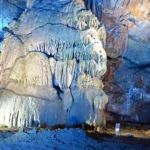Imagine a massive granite monument inscribed with cryptic messages in multiple languages, often compared to Stonehenge. The Georgia Guidestones, shrouded in mystery and controversy, have sparked intrigue since their erection in 1980. Who built them? What do they mean? And why were they destroyed? This guide uncovers the fascinating history, messages, and theories surrounding these enigmatic stones.
What Were the Georgia Guidestones?
The Georgia Guidestones were a set of six granite slabs standing in Elbert County, Georgia, inscribed with ten guiding principles in eight different languages. The monument was commissioned by a man using the pseudonym R.C. Christian in 1979 and unveiled in 1980.
Key Features:
- Height: 19 feet 3 inches
- Weight: Over 237,000 pounds
- Languages: English, Spanish, Swahili, Hindi, Hebrew, Arabic, Chinese, and Russian
- Purpose: Serve as a guide for humanity in the event of global catastrophe
The Inscription: The 10 Guiding Principles
Each stone was engraved with ten statements, often interpreted as commandments for a future society:
- Maintain humanity under 500,000,000 in perpetual balance with nature.
- Guide reproduction wisely—improving fitness and diversity.
- Unite humanity with a living new language.
- Rule passion, faith, tradition, and all things with tempered reason.
- Protect people and nations with fair laws and just courts.
- Let all nations rule internally, resolving external disputes in a world court.
- Avoid petty laws and useless officials.
- Balance personal rights with social duties.
- Prize truth, beauty, love—seeking harmony with the infinite.
- Be not a cancer on the Earth—leave room for nature.
Who Built the Georgia Guidestones?
The true identity of the builder remains unknown. R.C. Christian approached the Elberton Granite Finishing Company in 1979, claiming to represent a group of anonymous individuals who wanted to leave a message for future generations.
Theories About the Builders
- Freemasons & Secret Societies: Some speculate that the Freemasons or the Rosicrucians were involved due to the name “R.C. Christian,” potentially referencing Christian Rosenkreuz, the legendary founder of the Rosicrucians.
- Global Elite & The New World Order: The first inscription—maintaining humanity under 500 million—has fueled conspiracy theories that the stones were part of an elite depopulation plan.
- Time Capsule Theory: Some believe a time capsule was buried beneath the site, but no definitive proof has been found.
The Mysterious Destruction of the Georgia Guidestones
On July 6, 2022, an explosion partially destroyed the structure. Due to safety concerns, the remaining stones were demolished later that day. Who destroyed them remains unknown.
Possible Reasons for Destruction
- Conspiracy Theories & Public Backlash: Some religious groups saw the inscriptions as “satanic commandments.”
- Vandalism & Political Motivations: Various political groups have criticized the monument over the years.
- Lightning Strike or Natural Causes: Though unlikely, some theorists suggest natural destruction.
Legacy & Impact of the Georgia Guidestones
Even after their destruction, the mystery of the Georgia Guidestones continues to captivate historians, researchers, and conspiracy theorists. Their messages—whether a warning, a guideline, or something else entirely—still spark debates worldwide.
Why They Still Matter
- Symbol of Free Speech & Mystery: Their controversial nature keeps them a topic of discussion.
- Tourist Attraction & Economic Impact: Before destruction, thousands visited annually.
- Lesson in Preserving Monuments: Their fate raises questions about how we preserve historical artifacts.
Conclusion
The Georgia Guidestones were more than just granite slabs—they were an enigma wrapped in stone. Though destroyed, their legacy lives on in conspiracy theories, historical discussions, and cultural intrigue. What do you think? Were they a warning, a guideline, or something else entirely?
Share your thoughts in the comments below! For more mysteries and Georgia travel guides, check out our latest articles on GeorgiaGuider.com.










